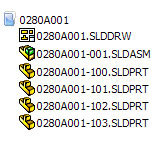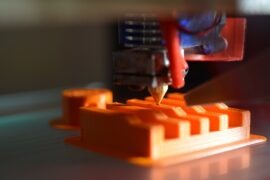
Everybody likes to know what they are getting. When it comes to organizing files on your computer it’s not any different.Using a smart numbering system may seem like a good ideas at first, but it invariably leads an organization down the wrong path. Why? Simply put, things change. This material become that material, that changes location, on and on till the break of dawn.
If I think about this, and try to come up with a clever analogy, smart numbers are like your favorite recliner. It’s comfy, has a leg rest, but it’s so big it only fits through one door and in one room. So it is with a smart part number. It works, right there.
For example, your part number differentiates between a part and an assembly. If you create a part and later it turns into an assembly, your part number is now meaningless and, even more, it’s confusing. To avoid this type of confusion, here’s a few guideline to use.
I realize I may be stepping on some toes here.
I know the man-years that go into developing naming conventions and numbering systems. This is intended to be a guideline to help out. Smart numbers were useful when files were stored in file cabinets. Today, that is less the case with files being stored servers and data being stored in databases.
Use a sequential alpha-numbering system
The part number only needs to be unique. To get the greatest combination of files with some added comfort, use something like this.
0280A001
This gives you over 1 and half times more numbers than if you went with a straight numbering system and it breaks up the monotony of a straight numerical value, i.e. it’s easier to remember, say and read 280A than 2801956.
Name SolidWorks files the same
SolidWorks has three file types. This will be easier to show than explain. Basically, all the stuff going in the drawing is named the same as the drawing. If you have everything in one folder it would look like this.

This keeps files associated with each other better organized and understood.
Use properties to control the rest
You can create a property for anything you want to control in a part, assembly or drawing. If this is just a field on a drawing you can revise the file to change the property. If it’s used in the part number, you’re in trouble, because, look at that, it’s already been used a gazillion other places.
Think of the other documents
What other documents will you need to generate to capture change? Change Orders? Change Notices? You have a change that affects multiple parts, assemblies, locations, materials, etc. That smart number isn’t going to do much good there. You can vastly uncomplicated your documentation and engineering efforts by having one single sequential numbering system.
Start at 1
You start counting at 1, start your numbering at 1, or rather 0001 for the number of characters you plan to use. Same with revisions, alpha or numeric. Start with 1 or start with A. This way you’ll get files listed nice and clean.
0001
0002
0003
0004…
A
B
C
D…
Smart part numbers are comfy because by human nature we use numbers to remember physical things. The bottom line is, a dumb sequential numbering system will save you from a lot of grief. What has your experience been? Are there exceptions?


![6 Types of Civil Engineering Drawings [Detailed Guide]](https://www.solidsmack.com/wp-content/uploads/2023/12/Civil-Engineering-Drawings-270x180.jpeg)
